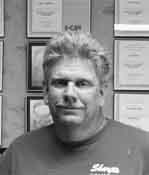 | Richard Smith has been in the Auto Body Industry for 26 years. He is ASE Certified Master Collision Tech, an I-Car Platinum Tech, and an I-Car Instructor. He and His wife own and operate Sharp's Auto Body & Collision Inc. located at 202 North Elm St. in Pittsburg, Kansas. He is a father of 5 children, Ex Military E-6 Staff SGT. and is active in his home Church. The one thing he enjoys doing is educating the public about the safety and proper repair of automobiles, no matter if it is a vehicle that has been in a collision, a small dent, or a complete restoration. The shop is always equipped with a skilled professional to handle your auto needs. |
Automotive Service & Repair
2012-08-30 08:41:33
What should I expect in the auto paint process?
Q- I am considering getting my car painted in the near future. What should I expect in the process?
A- First, you should expect that the surface of the car be prepared. This involves removing any surface rust and repairing any dents. The dent removal process might vary from shop to shop. If you have any large dents, and can’t get to the back side, use a dent removal tool that welds stud to pull dent out instead of drilling holes to pull dent out. You have to know what type of metal or material you are working with to determine how it will be repaired or replaced.
Next, your car will be primer. Applying primer is necessary so that the paint will have an even appearance. Primer is a very important stage of the process. You will want a quality 2K or Polyester primer because your paint can only look as good as the base under it. Next there are several options - single, two, or three stage painting.
If you are opting for a single stage paint job, then after the surface is prepared the car is painted in one step with the paint containing all of the necessary chemicals mixed in. This is a simpler and less expensive process, but also less durable.
A two stage paint job uses a base coat over the primer then covered with a clear coat. This option is much more durable and if cared for properly will last years before needing another paint job.
In three-stage painting, your car would be painted first with a base coat, then a mid coat color, then the clear coat.
Your choice may depend on the type or age of the car. Talk to an automotive specialist about your options and they can help you determine which option is best for you.


